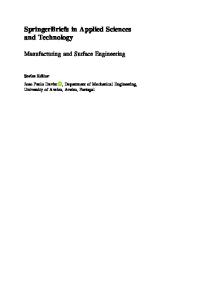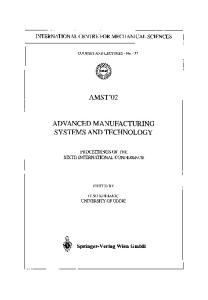Multi-response Optimization in Machining Inconel-625 by Abrasive Water Jet Machining Process Using WASPAS and MOORA
- PDF / 4,351,327 Bytes
- 15 Pages / 595.276 x 790.866 pts Page_size
- 34 Downloads / 313 Views
RESEARCH ARTICLE-MECHANICAL ENGINEERING
Multi-response Optimization in Machining Inconel-625 by Abrasive Water Jet Machining Process Using WASPAS and MOORA P. Venkateshwar Reddy1,2
· G. Suresh Kumar2 · V. Satish Kumar2
Received: 22 May 2020 / Accepted: 17 September 2020 © King Fahd University of Petroleum & Minerals 2020
Abstract Certain materials that are used in industries to manufacture parts, components and sub-assemblies are difficult to machine using traditional machining processes. Abrasive water jet machining is a viable solution to such a problem, and its use is sought where precision is the requirement. The process involves many input controllable parameters that influence the performance characteristics of the process such as MRR, surface finish and kerf width. Inconel-625 is one such hard-to-machine material that finds many applications in industries. The objective of the present work is set to ascertain experimentally the influence of three input parameters on the three responses mentioned above through ANOVA. WASPAS and MOORA are two powerful techniques that are used for multi-objective optimization, and the ranks of both the MCDM methods were observed to be same. Traverse speed and abrasive mass flow rate are proven to be statistically significant on MRR and surface finish, whereas standoff distance along with the above two parameters is also significant on the response kerf width. Machined surface morphology is studied using scanning electron microscopy. From the SEM morphology, it was confirmed that the higher abrasive flow rate obtained rough surface finish. Keywords AWJM · WASPAS · MOORA · Optimization · Surface roughness
1 Introduction New materials are incessantly evolving to congregate the demand for the ultra-supercritical power plants. Various superalloys like Inconel-617, Inconel-740, Nimonic 263, Haynes 230 and Nimonic-263 have been recently developed to suit for these applications [1, 2]. All the above-mentioned nickel alloys are harder materials to machine by usual machine tools and also due to high chemical reactivity. Moreover, other parameters like high strain hardening, fragmented chip formation, higher hot hardness, self-induced babble and stumpy thermal conductivity with deprived heat indulgence at the tool edge are also considered as the difficult reasons for machining by conventional methods [3, 4]. Due to these reasons, nickel-based alloys required special attention. AWJM
B
P. Venkateshwar Reddy [email protected]
1
Department of Mechanical Engineering, JNTU Ananthapur (GPREC Research Centre), Ananthapuramu, Andra Pradesh, India
2
Department of Mechanical Engineering, G Pulla Reddy Engineering College, Kurnool, Andra Pradesh, India
is considered as the special alternative machining process which is popularly exploited for machining the advanced and hard-to-machine metals. Like other machining processes, AWJM process performance is also considered in terms of the material removal rate, surface roughness, geometrical defects like kerf and taper angle. All the above
Data Loading...











